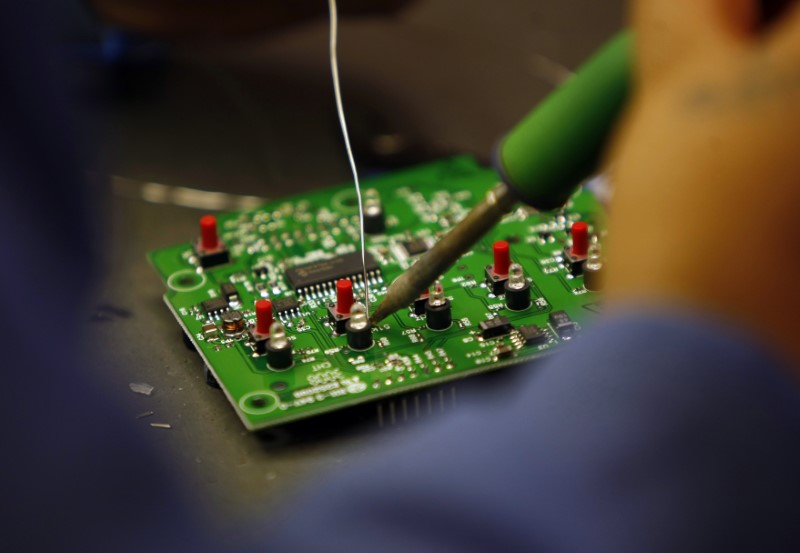By Lucia Mutikani
WASHINGTON (Reuters) - New orders for U.S. manufactured capital goods unexpectedly fell in September amid weak demand for computers and electronic products, which could temper expectations for an acceleration in business spending in the fourth quarter.
Despite the prolonged energy-driven weakness in manufacturing, the rest of the economy is in better shape. Other reports on Thursday showed a drop in the number of Americans applying for unemployment benefits last week and a jump in contracts to purchase previously owned homes in September.
"We are still seeing the effects of the downturn in energy production. The service industries continue to drive economic growth, that will probably remain the case through the rest of this year," said Gus Faucher, senior economist at PNC Financial Services Group (NYSE:PNC) in Pittsburgh.
The Commerce Department said non-defense capital goods orders excluding aircraft, a closely watched proxy for business spending plans, fell 1.2 percent after three straight months of strong gains.
These so-called core capital goods orders increased 1.2 percent in August. Economists had forecast core capital goods orders rising 0.3 percent last month.
Shipments of core capital goods rose 0.3 percent after being unchanged in August. Core capital goods shipments are used to calculate equipment spending in the government's gross domestic product measurement.
But those shipments still fell at a 4.4 annualized rate in the third quarter. That implies business spending on equipment likely remained weak in the third quarter. The government will publish its first estimate of third-quarter GDP on Friday.
Growth estimates for the July-September period are currently as high as a 3.6 percent annualized rate, reflecting a solid pace of consumer spending and strong exports. The economy grew at a 1.4 percent pace in the second quarter.
TIGHTENING LABOR MARKET
The improving economic picture was underscored by a separate report on Thursday from the Labor Department showing initial claims for state unemployment benefits decreasing 3,000 to a seasonally adjusted 258,000 for the week ended Oct. 22. That marked 86 straight weeks that claims have been below the 300,000 threshold, which is normally associated with a strong job market. That is the longest stretch since 1970, when the labor market was much smaller.
In a third report, the National Association of Realtors said its pending home sales index, based on contracts signed last month, rose 1.5 percent. These contracts become sales after a month or two, and last month's increase pointed to further gains in home resales, which surged 3.2 percent in September.
The dollar was little changed by the data, while U.S. stocks were trading marginally lower. Prices for longer-dated U.S. Treasuries fell.
Manufacturing, which accounts for 12 percent of the economy, is struggling with the lingering effects of a strong dollar and sluggish overseas demand, which have cut into the profits of multinational corporations. Companies, especially in the energy sector, have responded by slashing capital spending budgets.
Though overall business spending rebounded modestly in the second quarter, investment on equipment has been subdued since late 2015.
With the dollar's rally appearing to have peaked and oil and gas drilling activity rising in recent months, there is cautious optimism that the worst of the equipment spending rout is over.
"The stronger trend in core capital goods orders suggests equipment spending could return to positive territory in the fourth quarter, but we do not expect a robust turnaround," said Tim Quinlan, a senior economist at Wells Fargo (NYSE:WFC) Securities in Charlotte, North Carolina.
Heavy machinery maker Caterpillar (N:CAT) this week reported a 49 percent drop in third-quarter profit from a year ago and lowered its full-year revenue outlook for the second time this year.
Caterpillar said demand for new heavy machinery had been undercut by an "abundance" of used construction equipment, a "substantial" number of idle locomotives and a "significant" number of idle mining trucks.
A 44.8 percent plunge in demand for defense equipment pushed down overall orders for durable goods, items ranging from toasters to aircraft that are meant to last three years or more, by 0.1 percent last month. That followed a 0.3 percent increase in August.
There were also declines in orders for primary metals and fabricated metal products. Orders for machinery and electrical equipment, appliances and components rose last month.

Pointing to continued manufacturing weakness in the near-term, unfilled orders for durable goods fell for a fourth consecutive month in September, while inventories increased for a third straight month.